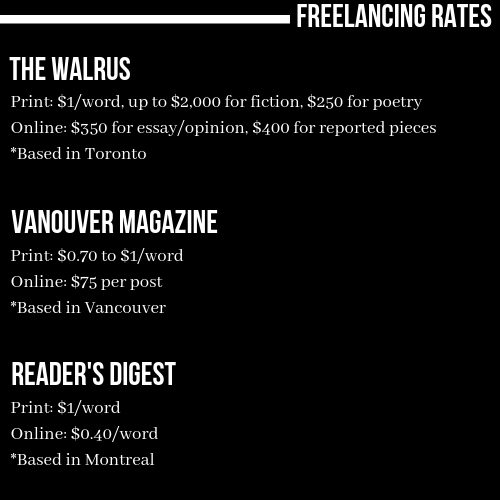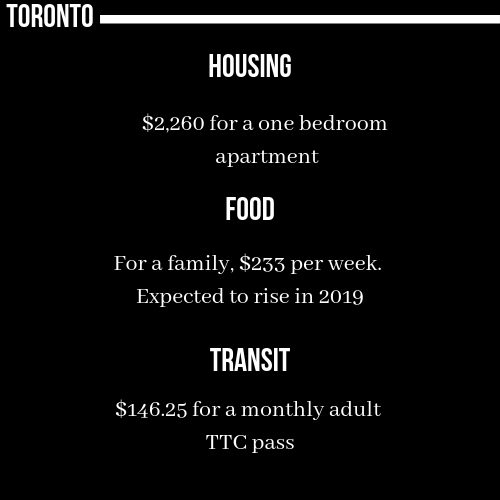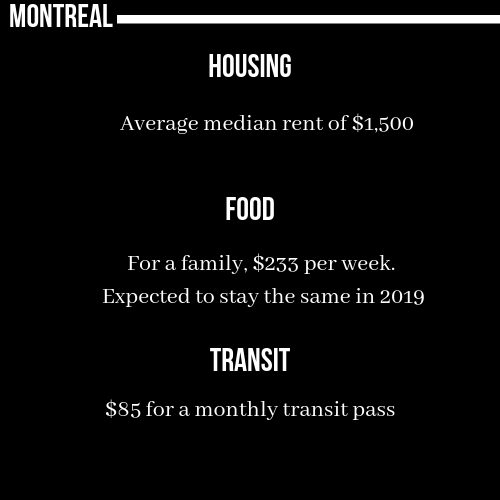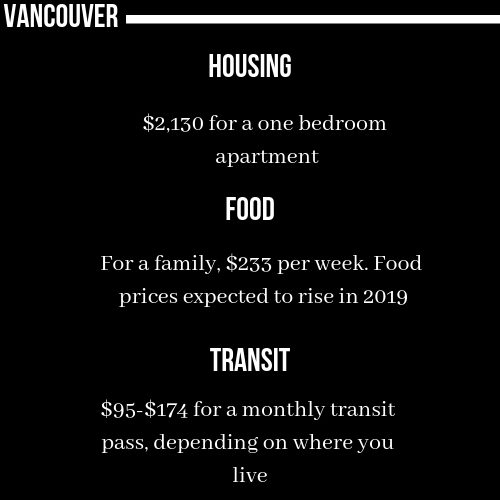Freelancing is the reality for many journalists, as well as those in other fields.
A 2017 report from Intuit Canada showed that 37 per cent of Canadians were self-employed.
As newsrooms continue to shrink, many journalists are forced to enter the freelance market.
In recent months cuts have impacted the staff rooms of The Canadian Press, BuzzFeed and the Huffington Post.
But working as a freelancer isn’t new for some journalists and many have already been on the hustle for years. The RRJ spoke with freelancers in Canadian urban centres like Toronto, Montreal, and Vancouver, to see how they balance the cost of living with freelance contracts.



Erin Pepler, corporate blogger and freelancer, 34 (@erinpepler)
As a mother of two, Pepler is already busy enough, and her choice to freelance has a lot to do with her kids. Her son even runs into the room during our call to show her something and she has to send him out so we can keep talking. By working from home, she is able to pick up and drop off her kids and go to watch their recitals whenever she wants.
She’s been freelancing for 10 years and writes about parenting, home design and is trying to get back into lifestyle writing. In addition to this, Pepler writes copy for businesses. “I always say it supplements it,” says Pepler. “It is more income for me, for sure. I can charge exponentially more for a blog post that I write for a business…than I can for an article I’m writing with my name on it.”
She estimates her income from one corporate blog post equals what she makes from taking on two to three journalism assignments.
Pepler and her husband own a home in Burlington, Ont. They used to live in Toronto’s Annex neighbourhood, but when they had children, it just got too expensive. Rent was $1,800 a month at their old apartment, whereas their now mortgage is just $1,100 a month.
Now they also own two cars and pay for their kids’ extra curricular activities. Her husband works at McMaster University and gets a regular paycheque every two weeks, but this is not the case for her. “For me, for the work to be there, I have to get the work. I have to pitch, I have to provide something of good quality,” says Pepler. “For the corporate stuff I really have to hustle and be there for people at the drop of a hat…because that is the better paying work and I can’t afford to lose that.”
Pepler devotes 25 to 35 hours a week on writing corporate copy and about 10 to 20 on editorial writing, though it depends on the week. “I never work less than 40 hours,” says Pepler. “I have to balance everything and know I’m not taking on more work than I can do.” She hopes she can soon do more editorial work, as that’s her true love. She is also working on a non-fiction book.
She spends a lot of time planning out her work and projected payments to ensure her family is in good shape. “It’s still precarious. There’s no guarantee of the work being there next week, next month or next year,” she says. “I feel like even if I took a big leap of faith and said, ‘You know what, I’m going to forget all this corporate stuff and I’m just going to go all in with the editorial,’ it might go amazing some months but there’d be months where there’d be complete lulls.”
Deidre Olsen, intern, student, content writer and freelancer, 28 (@DeidreLOlsen)
Olsen has been a full time freelancer since September 2018, but has been freelancing on-and-off since 2015. They currently work as an intern at the West End Phoenix, where they earn $500 a month, and are also a 2019 fellow at the Munk School of Global Affairs and Public Policy.
They write for pubs like Now Magazine, Leafly and Canadaland. “All those companies pay fast or well, or both,” says Olsen. They only write for publications that “actually pay,” as they need to make sure they have enough money to pay rent and bills. Their apartment is about $900 a month, and in addition they pay $200 a month for transit and around $225 in other bills as well as food.
Olsen also does a lot of content writing, which they say is “complementary income,” but acknowledge it is their main source of revenue, earning about $1,900 a month. “It’s kind of nice to have stable income that’s not that challenging because then I can focus more energy on my passion projects, my internship and my school,” says Olsen.
Olsen finds that pitching so much for school takes up a lot of their energy, so the content writing is a nice balance. Still, the industry can be tough. “[It’s] very precarious. I honestly am not sure if I could do it without having the content writing aspect,” they say. “I think it’s nice to have a varied income as a freelancer because it’s more sustainable for my mental health. I find that when I’m solely pitching stories I get very depressed because I feel like I have to turn every single aspect of my life into content and that gets really draining.”
Kat Armstrong, marketer and freelancer, 39 (@kitten_arms)
Freelancing since 2013, Armstrong does “a little bit of everything.” She writes for Today’s Parent, Brit + Co, the United Church Observer and has written for Playboy in the past. She writes about five to 10 stories a week and does marketing work, and has three young children.
However, her future as a freelancer is uncertain. “I don’t know, economically speaking—especially living in Toronto with three kids and daycare costs—I don’t know that freelancing will be feasible past 2019 for me.” Armstrong has to budget for payments on her triplex rental in Toronto, her car, daycare, groceries and a YMCA membership for her children.
“Every month I try to write down all of my expenses, even though they generally don’t change that much from month to month,” says Armstrong. Knowing it can take about a month to get paid, she sets money aside for extra expenses, such as clothes for her kids.
“I feel like I’ve had a lot of luck,” says Armstrong. “I’ve worked with a lot of good editors and most of my editors have been women of colour, which I know is very rare but it’s been very wonderful to work with these women.”
But the “hustle,” is exhausting, she says. She finds support through friends she has made who write for different beats and editors, adding that it’s “helpful and grounding” to be able to have this kind of support network.
Amanda Scriver, social media and event planner, freelancer, 35 (@amascriver)
Scriver used to work with Postmedia doing digital work but when she heard there would be layoffs, she decided to go fulltime as a freelancer, saying she wanted to focus on her writing work. She has now been freelancing for three years.
Scriver does about four to eight pieces a month for Brit + Co and has a twice monthly column with Leafly. She also writes features for Now Magazine on a pitch-by-pitch basis and used to write a regular column for The GrowthOp. Last year, she wrote 120 stories in addition to her other work as a social media and event planner, where she primarily works on contract.
“I can plot out what I need in the future and how I can sort of financially plan for myself. On the flipside, it helps me for my writing work because I’ll know how busy I’m going to be for these clients,” says Scriver.
She works out of a co-working space in the city, finding it too hard to work from home. She currently pays for an apartment in Toronto (that she shares with her partner), as well as the TTC and food. When she went freelance, she decided to hire an accountant, whom she meets with once a month. “I was like, ‘I write words, I don’t do math!’” Hiring an accountant has been positive for Scriver, as they work together to analyze past months’ income and keep track of her workflow. “I don’t think I could do that on my own,” says Scriver.
Being able to freelance and set her own hours has given Scriver time to work on her mental health. “I’ve been able to see a therapist whenever I want. I’ve been able to take part in programs…when I was working full time I couldn’t explore those options.”


Nora Loreto, 34 (@NoLore)
When Loreto moved to Quebec City, she had “literally nothing,” so going freelance was her only option. She has a contract with the Canadian Association of Labor Media, which gives her about 20 hours of work a week. She’s also a columnist for the National Observer, a contributor to the Washington Post and working on her second book, which is set to hit shelves in 2020. Occasionally, she’ll do some work as a translator. “The more I got established, the more I was able to take…on,” she says.
“Basically every minute my kids are in daycare, I’m working,” says Loreto. She works from her home office at her apartment in downtown Quebec City which she shares with her partner, who works at a university. They have no car and spend about $80 a month on transit, as well as about $600 a month on food for a family of four. She also has to pay her mortgage (along with maintenance fees), and wifi, cellphone and hydro bills. This year, Loreto projects her total income will be about $42,000 to $50,000.
While she loves the freelancing life, it does have its drawbacks. “It’s lonely and isolating. I have literally no colleagues,” says Loreto. “I actually can go easily a full day without talking to anybody.” She notes that because she works from home, she has no work friends and loses out on the office environment.
But at the end of the day, “I love writing,” she says. “I look forward to it every weekend, every night I look forward to coming back to my office to work, starting my day.”


Sarah Amormino, 25 (@sarahamor)
Amormino graduated from Ryerson University two years ago and now lives in an apartment on Commercial Drive in Vancouver, and often bikes to get where she needs to go. Rent is her biggest expense. “It’s so stupidly expensive in this city,” she says.
Amormino does technical writing and also writes arts and culture content for SAD Mag, a Vancouver publication. She is in contracts until November 2019 for her technical writing for a car-financing company, which takes up a lot of her time. “My goal is to get out of contracts completely and freelance for a bunch of different publications,” says Amormino. But her contracts pay the bills, she says, and freelance doesn’t.
She is constantly pitching and says it takes a lot of motivation. “When you’re a freelancer, you’re essentially an entrepreneur,” she says. “And when you’re not apart of a team and you’re your own boss, it’s hard to pick that motivation up because you don’t really have anyone in your corner rooting for you.” Amormino adds that, “You have to figure it out on your own.”
She keeps an agenda, but says budgeting isn’t her strongest area. “It’s hard not to live paycheque-to-paycheque when you’re 25-years-old and just starting off in your career.”
Images and graphics by author
